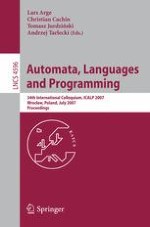2007 | Buch
Automata, Languages and Programming
34th International Colloquium, ICALP 2007, Wrocław, Poland, July 9-13, 2007. Proceedings
herausgegeben von: Lars Arge, Christian Cachin, Tomasz Jurdziński, Andrzej Tarlecki
Verlag: Springer Berlin Heidelberg
Buchreihe : Lecture Notes in Computer Science
